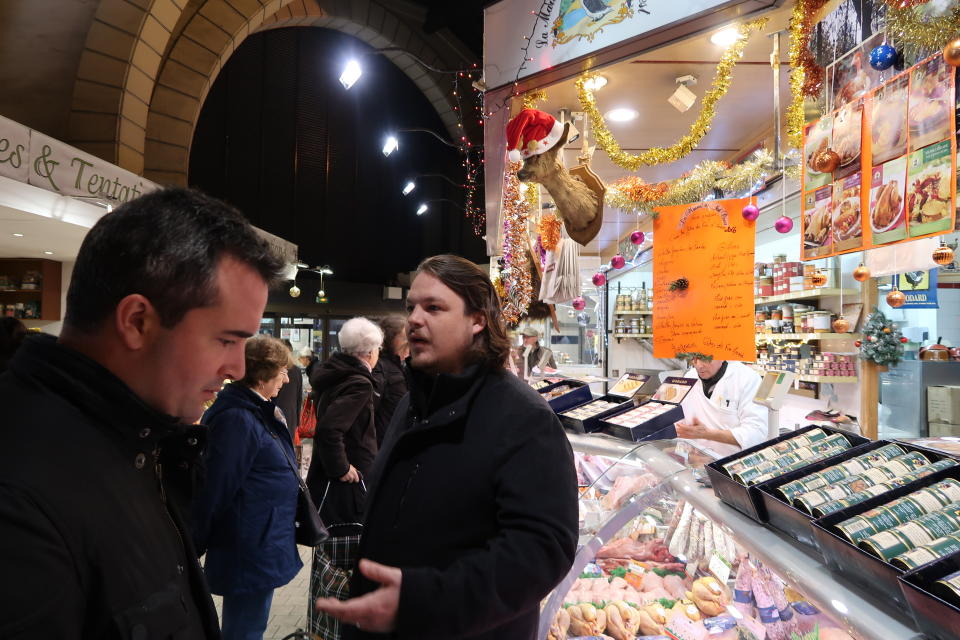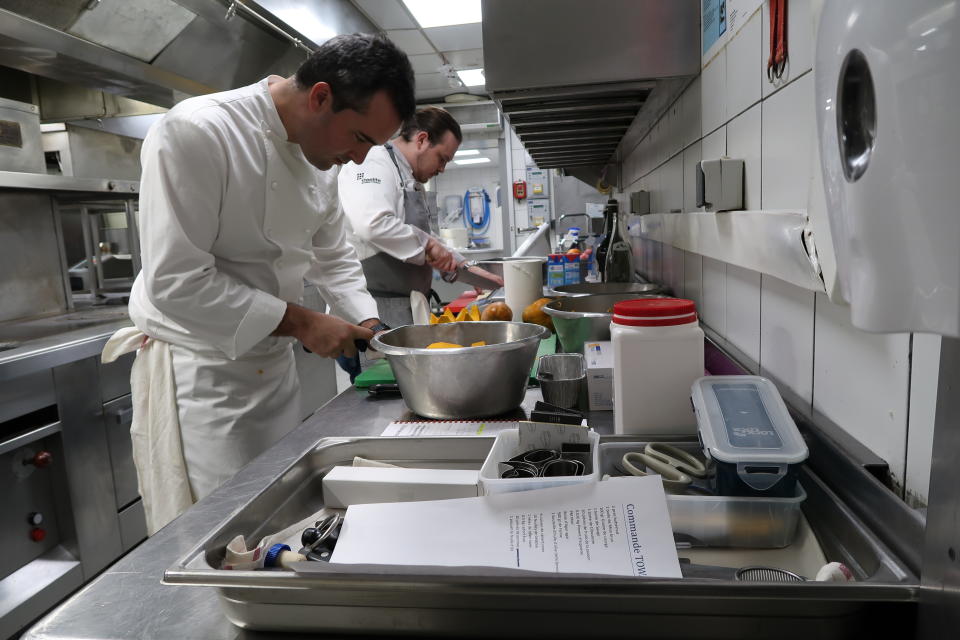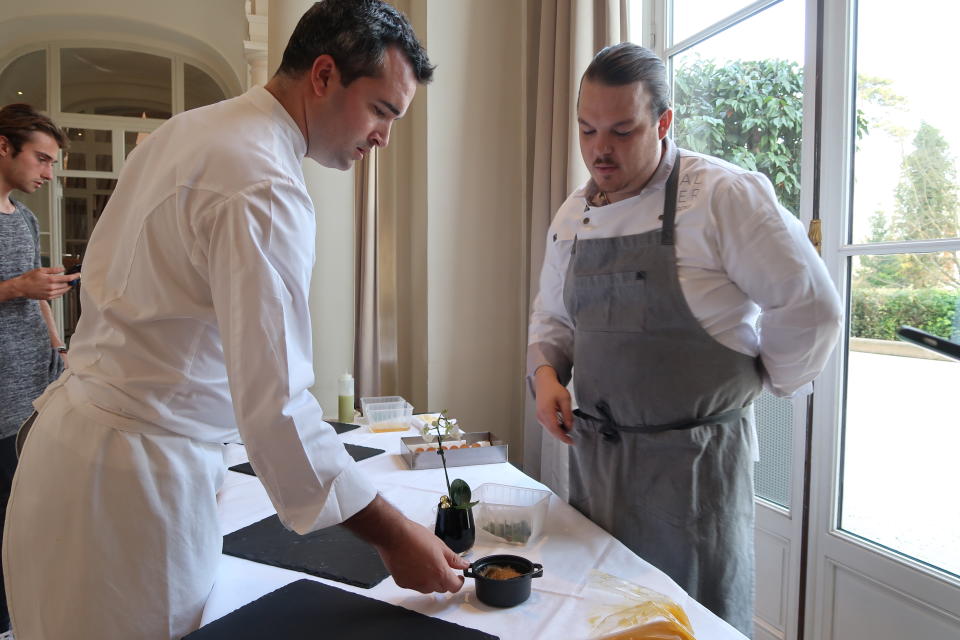Behind the Scenes With Brad Kilgore at A Taste of Waldorf in Versailles
Over the past three months, five of the world's top chefs, all James Beard Rising Star semi-finalists, have been traversing the globe, holed up for weeks at a time at some of the Waldorf Astoria's most luxurious properties—Park City, Ras Al Khaimah, Grand Wailea, Boca Raton, and Versailles. While on location, they've been in secret summit with the hotels' executive chefs, all with a common goal: to create two signature small bites and accompanying cocktails for the annual A Taste of Waldorf Astoria competition and the launch of the hospitality brand's "Fifth Hour"—a new take on happy hour set to roll out across 26 international properties in the new year.
Among the anointed is Brad Kilgore, a 2016 Food & Wine Best New Chef, whose Miami restaurant, Alter, is one of the most-heralded new destinations in North America—and best known for its inventive, playful cuisine. Last week, Food & Wine traveled to France with Kilgore to go behind the scenes as he teams up with Executive Chef Frederic Larquemin at the Trianon Palace in Versailles for an intensive week of research and development. The duo, who had neither met nor communicated before the trip, are tasked with creating two dishes (details of which we are not at liberty to divulge here) and drinks to present at a final judging in February in New York City.
Here's what happened.

© Danica Lo
Brad Kilgore and Frederic Larquemin meet for the first time at the Trianon Palace Versailles.
Throwing two strangers, both top chefs—captains of their own domains—into competition together is never guaranteed to be an easy ride, but Kilgore and Larquemin find immediate synergy and common ground.
"We have some similar background and similar training," Kilgore says. "In particular, Frederic worked at Louis XV in Monaco. Before he worked there, my old chef [at Chicago's L20] Laurent Gras was the executive chef there—they didn't cross paths, but he definitely knows who [Gras] is and heard stories, so in terms of that sort of baseline training and understanding of cooking techniques, he and I see eye-to-eye on a lot of it."
The first 36 hours on the ground in Versailles are dedicated to ice-breaking, and Larquemin and Kilgore play several rounds of the name game. "There are always a few connections," Kilgore says. "Once you get up to a higher level of cuisine—and I think that's for any field in any market—you're only a few steps away from Kevin Bacon. It's just a good way to connect, especially if you have a funny story about somebody."
We drive into Paris on a rainy Monday night and wind up at La Grande Epicerie at Le Bon Marche. After two rounds of oysters at the raw bar, the chefs take a spin around the food hall, picking up some condiments for potential use in a final dish.

© Danica Lo
Larquemin and Kilgore find a key condiment at Le Bon Marche in Paris.
By Tuesday morning, Kilgore and Larquemin are swapping menu strategies. Larquemin has only recently joined the Trianon Palace Versailles from his post as executive chef at IDAM, an Alain Ducasse restaurant in Qatar—and he plans on bringing new flavors and dishes to the hotel property in the new year.

© Danica Lo
Kilgore and Larquemin talk menu strategies over coffee before hitting the local market.
The local market square in Versailles hosts both indoor and outdoor vendors—and the stands are teeming with quality local produce, meats, seafoods, and cheeses. Larquemin and Kilgore kick the morning off on the hunt for duck, foie gras, mushrooms, persimmons, and pumpkin—initial ingredients for starter concepts that are iterated and evolved minute-by-minute as they ideate walking through the market.

© Danica Lo
The chefs are constantly ideating as they walk through the market and are inspired by local ingredients.
Watching them work and hearing recipes conceptually evolve throughout the course of a single morning on hair-trigger inspiration and gut instinct is fascinating. The nature of the competition is complex—developing regionally-inspired small bites with universal appeal that will also please the palates of the Waldorf Astoria's expert judging panel—and Kilgore and Larquemin are pros, firing out-of-the-box ideas in real-time. Just imagine the most technically-advanced, intellectually intense conversation you've ever felt not-quite-brilliant-enough to participate in—now try to distill it all down to just two canapes.
"This is the first exercise like this that I've done with a chef I've never met before," Larquemin tells Food & Wine. "It's very interesting to have someone come from a place I've never been who'd had a totally different experience with other chefs who I've never worked with, with another vision, and other knowledge."

© Danica Lo
Kilgore and Larquemin take a look at the mushroom stand at the open-air market in Versailles.
While both chefs brought their own ideas to the table on day one, the collaboration took all their a priori concepts to the next level. "In the beginning, I had my own ideas and recipes, and I think he had his, too," Larquemin says. "But afterwards, when we fused the two ideas, they became totally different from what I did and, I'm sure, from what he did. So that was interesting. When you work together, you can really achieve so much more—if you have an idea and I have an idea, we exchange ideas, and now I have two ideas and you have two ideas. So that's good."

© Danica Lo
Kilgore and Larquemin sit down to hash out the details on day two.
By Wednesday the chefs are well underway with initial preparations in the kitchen, so in the morning we head off for a culinary history tour of the Chateau de Versailles—where Larquemin and Kilgore find presentation inspiration in the gilded palace and the Sun King's napkin folding techniques.

© Danica Lo
Larquemin and Kilgore visit the legendary Chateau de Versailles.

© Danica Lo
The lily pad napkin fold, directly descended from the Chateau de Versailles.
The duo spend the rest of the afternoon in the kitchen before workshopping the paired cocktails in the afternoon with the Trianon Palace bartender.

© Danica Lo
Larquemin and Kilgore work together on recipes for the two paired cocktails.
"We were able to take the cocktails and mold them to the dishes, and also take parts of the dishes and mold them to the cocktails," Kilgore says. "So they could grow together—especially with the ingredients.

© Danica Lo
Kilgore and Larquemin explore the seafood hall at Rungis market in France.
That night, in wee hours of the morning—at 1:30 a.m. on Thursday—we all convene in the hotel lobby for an all-night excursion to Rungis market, the largest wholesale food market in the world. It's a rare privilege for outsiders to be privy to this insider's nocturnal world of the country's top seafood, meat, tripe, and produce suppliers—and the sheer breadth of what's on offer is inspiring and mind-boggling. Luckily, we've got an in (Chef Larquemin's fish supplier) and after an epic tour, we end the night (morning?) with a 5 a.m. steak supper at L'Aloyau, on the market grounds, before heading back to the Trianon Palace to pass out.
By the time Friday afternoon's tasting rolls around, Kilgore and Larquemin are practically old buddies. "When you get two chefs together, it can be difficult," Kilgore says. "But Frederic and I really worked well together. It went easier than I expected. Going back to working with someone else, we were both really comfortable working together. At the same time, working in new kitchens is always difficult—luckily we're in a very well-equipped one that had all the little toys I needed to get the job done."
The result: Two stellar Versailles-inspired small bites and accompanying cocktails that will make their competition debut in February at the Taste of Waldorf finals in New York City. Facing off will be entries from top chef duos from all over the world, and the winning dishes will be placed on the bar menus at 26 international Waldorf Astoria properties. It was a daunting task, but we think that Kilgore and Larquemin have got it nailed.
"This has to be made all over the world, if it wins, in 26 different properties," Kilgore says. "You've got to keep that in mind. So we decided to not use a main ingredient with alcohol in it—for those who don't drink—and we decided not to use pork. We also wanted to make the cocktails with alcohol and without—both cocktail and mocktail. That way, anyone can have these—they'll appeal to the masses."


